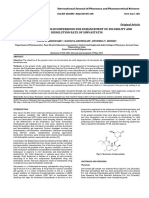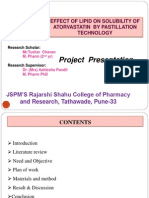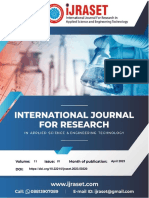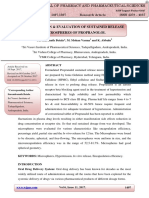Pioglitazone Naopaticles
Pioglitazone Naopaticles
Uploaded by
Atiq Ur-RahmanCopyright:
Available Formats
Pioglitazone Naopaticles
Pioglitazone Naopaticles
Uploaded by
Atiq Ur-RahmanOriginal Title
Copyright
Available Formats
Share this document
Did you find this document useful?
Is this content inappropriate?
Copyright:
Available Formats
Pioglitazone Naopaticles
Pioglitazone Naopaticles
Uploaded by
Atiq Ur-RahmanCopyright:
Available Formats
WORLD JOURNAL OF PHARMACY AND PHARMACEUTICAL SCIENCES
Chowdary et al. World Journal of Pharmacy and Pharmaceutical Sciences
SJIF Impact Factor 2.786
Volume 4, Issue 04, 1638-1648. Research Article ISSN 2278 – 4357
FORMULATION AND CHARACTERIZATION OF PIOGLITAZONE
HYDROCHLORIDE NANOPARTICLES
Appana Chowdary K*, Navya Lakshmi Raju Suravarapu and Swathi Meddala
St. Ann’s College Of Pharmacy, Andhra University, Vizianagaram, Andhra
Pradesh- 535003, India.
Article Received on ABSTRACT
19 Feb 2015,
The oral bioavailability of poorly water soluble drugs improved using
Revised on 07 March 2015, Nanoparticles. The present research work is an attempt to develop and
Accepted on 28 March 2015
evaluate the Pioglitazone Hydrochloride Nanoparticles in order to
improve it, s solubility and bioavailability of poorly water soluble
*Correspondence for
Author drug. Nanoparticles were prepared by Polaxomer 188, Tween 80 and
Appana Chowdary K Poly Vinyl Pyrrolidine as stabilizers by Nanoprecpitation technique.
St. Ann’s College Of The prepared Nanoparticles evaluated for Particle Size, Zeta potential,
Pharmacy, Andhra
Fourier Transform Spectroscopy, Differential Scanning Calorimetry,
University, Vizianagaram,
Drug Content, Drug Entrapment Efficiency and In- Vitro Drug
Andhra Pradesh, India.
Release. The effect of different types of stabilizers and different types
of polymers were studied to see their effect on morphological, physical and dissolution
properties of Pioglitazone Hydrochloride was studied. The average particle size of
Piogllitazone Hydrochloride was found to be in the range of 100-500nm. Differentail
Scanning Calorimetry studies showed the crystallinity of precipitated Nanoparticles was
decreased than the pure drug. Data of in-vitro drug release shown that the prepared
Nanoparticles showed enhanced dissolution which may result in enhanced solubility. Among
all the formulations the formulation prepared with Polaxomer 188 in 1% concentration as
stabilizer and Eudragit L 100 as polymer in Acetone gave good results than others.
KEY WORDS: Pioglitazone Hydrochloride, Nanoparticles, Precipitation Technique.
INTRODUCTION
The major problem associated with many newly developed pharmaceutical drugs is poor
solubility in water and simultaneously in organic media. The basic challenge associated with
poorly soluble drugs is poor bioavailability/ erratic absorption. In case of poor bioavailability
www.wjpps.com Vol 4, Issue 04, 2015. 1638
Chowdary et al. World Journal of Pharmacy and Pharmaceutical Sciences
after Oral administration, many times Parenteral administration can’t solve problem.
Available strategies for enhance the solubility of poorly soluble drugs include: Aqueous
mixture with an Organic Solvent, Solubilization, Formation of complexes, Solid Dispersion,
Co-Crystallization and the effect of pH or Salt form. Recent drug delivery mainly focuses on
nanotechnology based strategies for poorly water soluble drugs in order to improve their
therapeutic performance.[1]
A Nanosuspension is sub micron colloidal dispersion of drug particles. A pharmaceutical
Nanosuspension defined as very finely divided, colloidal, biphasic, dispersed and solid drug
particles in an aqueous vehicle, size below micrometer, without any matrix material stabilized
by surfactant and polymers prepared by suitable methods for drug delivery application
through various routes of administration like Oral, Topical, Parenteral, Occular and
Pulmonary administration.[2] The particle size distribution of solid particles in
Nanosuspension is usually less than one micron.[3]
The Nanoprecpitation technique for Nanoparticles preparation was first developed and
patented by Fessi and Co-workers. This technique presents numerous advantages, is in that
straight forward technique, rapid and easy to perform.[4]
Piogliatazone Hydrochloride is an Anti-Diabetic drug. According BCS Pioglitazone HCl is
classified as class-II agent [Poorly Water Soluble and Highly Permeable]. Pioglitazone HCl is
insoluble in Water but soluble in organic solvents like Methanol, Dimethyl sulfoxide and
Dimethyl formamide with the molecular weight and melting point 390.20D and 1820C
[5]
respectively . Pioglitazone extensively metabolized by Hydroxylation and Oxidation and
the metabolites partially converted to Glucorinide or Sulfate conjugates. Following, oral
administration 15- 30% drug recovered in urine.[6]
The aim of present study is to formulate Nanoparticles of Pioglitazone HCl by
Nanoprecpitation technique. The impact parameters on particle size formation including
different type of stabilizers and type and concentration of polymers and stirring time was
studied.
MATERIALS
Pioglitazone Hydrochloride [Yaro Chem., Mumbai], Eudragit L 100 [Yaro Chem., Mumbai],
Eudragit Rs 100 [Yaro Chem., Mumbai], Polaxomer [Yaro Chem., Mumbai], Tween 80
www.wjpps.com Vol 4, Issue 04, 2015. 1639
Chowdary et al. World Journal of Pharmacy and Pharmaceutical Sciences
[Finar Ltd., Ahemadabad], PVP K 30 [Yaro Chem., Mumbai] and Methanol [Finar Ltd.,
Ahemadabad]. All other chemicals and reagents used were analytical grade used as received.
METHODOLOGY
Preformulation Studies[7]
Preformulation studies give the information needed to define the nature of drug substance and
provide a frame work for the drug combination with pharmaceutical excipients in fabrication
of dosage form. A thorough understanding of Physico-chemical properties may ultimately
provide a rational for formulation design are support the need for molecular modification
nearly conformed that there are no significant barriers to the compound development. The
Preformulation studies like study of organoleptic properties, determination of melting point
and determination of λmax was carried out.
Preparation of Pioglitazone Hydrochloride Nanoparticles by Precipitation Method
Pioglitazone Hydrochloride Nanoparticles Prepared by Nanoprecpitation method. Required
amount of polymer [Eudragit L 100 or Eudragit RS 100] were dissolved in suitable inorganic
solvent. The specified amount of drug was weighed and added to the polymeric solution and
allow to mix for few minutes to make air bubble free clear solution [Diffusing phase]. 1%
stabilizer was dissolved in distilled Water to form aqueous phase [Dispersing phase].
Accurately measured 1ml of polymeric solution [Diffusing phase] was added to the 10ml of
dispersing phase with the help of syringe on magnetic stirrer at room temperature resulted in
formation of Nanoparticles. As soon as polymer containing solvent diffuses into dispersing
medium, the polymer precipitated resulted in immediate drug entrapment. The rapid
Nanoparticles so formed is called “Marngoni Effect”, which is due to interfacial turbulence
that take place at interface of solvent and non solvent.
Table 1: Composition of Nanoparticles
S.No Ingredients F1 F2 F3 F4 F5
1 Pioglitazone HCl [mg] 30 30 30 30 30
2 Eudragit L 100 [mg] 1 - 1 - 1
3 Eudragit RS 100 [mg] - 1 - 1 -
4 Polaxomer 188 [mg] 10 10 - - -
5 Tween 80 [mg] - - 10 10 -
6 PVP K 30 [mg] - - - - 10
Acetone [ml] 5 5 5 5 5
www.wjpps.com Vol 4, Issue 04, 2015. 1640
Chowdary et al. World Journal of Pharmacy and Pharmaceutical Sciences
Fourier Transformed Infrared Spectroscopy
FTIR spectroscopy was employed to ascertain the compatibility between Pioglitazone
Hydrochloride Nanoparticles and selected excipients. The compatibility studies of FTIR [IR
Affinity-1, Shimadzu, Japan.] carried out in the range of 400-400-[1].
DSC Studies[8]
Thermograms of pure Pioglitazone HCl and sleeted excipients were obtained using DSC
4000 [Perkin Elmer, Singapore]. Indium standard S was used to calibrate the DSC
temperature and enthalpy scale. The samples were separately weighed and hermitically sealed
in perforated Aluminum pans. The system was heated from ambient temperature of 250 0C at
pre-programmed heating rate of 100C/min.
Solubility Study[9]
Solubility studies were carried out by preparing saturated solution of drug in water. An
excess quantity of drug with approximately 2ml of solvent was taken in vial with rubber
stopper then the vial was shaking for 24hrs at room temperature. After 24hrs sample was
centrifuged at 300rpm for 20mins. Than supernant liquid was pipette out from each sample
followed by dilution with suitable solvent and the solubility was determined in the UV-
Visible Spectrophotometer [Elico Double Beam SL-210] at 269nm.
Size Measurement and Zeta Potential Analysis[10]
The particle size and size distribution of Pioglitazone HCl Nanoparticles were determined by
Photon Correlation Spectroscopy using Zeta Sizer [Malvern 200 Instrument, U.K.].
Nanoparticles were diluted with filtered [0.22µm] ultra pure Water and analyzed using zeta
sizer. Zeta potential of nanoparticles was measured by zeta sizer. The zeta sizer mainly
consists of laser which is used to provide the light source to illuminate the particles within the
sample. Zeta sizer software produces a frequency spectrum from which electrophorotic
mobility hence zeta potential is calculated.
Entrapment Efficiency
The entrapment efficiency was determined by taking 2ml of Nanosuspension centrifuged
[Remi R 8C] at 500rpm for 30minutes. The amount of Pioglitazone Hydrochloride loaded in
Nanoparticles was calculated as the difference between the total amounts of used to prepare
to prepare the Nanoparticles and was found in supernant. The amount of free drug in
www.wjpps.com Vol 4, Issue 04, 2015. 1641
Chowdary et al. World Journal of Pharmacy and Pharmaceutical Sciences
supernant was measured at 269nm using UV-Visible Spectrophotometer after suitable
dilution with 1.2 buffer.
Percentage Drug Entrapment Efficiency= W Initial Drug- w Free Drug
W Initial Drug
Drug Content: The actual quantity of Pioglitazone Hydrochloride Nanoparticles formulation
was measured using UV-Visible Spectroscopic method after dilution with Methanol of 10mg
equivalent weight of formulation. The absorbance of sample measured at max of λ269nm.
Theoretical quantity of drug [TDC] in Nanoparticles was compared with actual quantity of
drug [ADC].
Drug Content= ADC/TDC 100.
In- Vitro Release Studies[11]: The In-Vitro drug release studies performed using diffusion
technique. The membrane was soaked before use in distilled water for 4 hours than rinsed
with distilled water. Pioglitazone HCl Nanoparticles dispersion was transferred into dialysis
membrane bag, tied and placed in beaker containing 500ml dissolution medium. The entire
system was kept at 37.5 ± 50g with magnetic stirring [50rpm]. At appropriate interval 5ml of
release medium was removed and 5ml fresh medium was added to maintain sink condition.
The amount of Pioglitazone HCl in the release medium was evaluated by U.V
Spectrophotometer at 269nm.
RESULTS AND DISCUSSION
Pioglitazone HCl is poorly soluble drug, which was belongs to class-II. Thus, it was
challenging to enhance the solubility of Pioglitazone HCl in aqueous medium. Precipitation
method has been employed to produce the Pioglitazone HCl Nanoparticles.
Preformulation Studies: Pioglitazone HCl was found to be White to Off- White crystalline
Powder and Odor less. The absorbance maxima of Pioglitazone Hydrochloride in 1.2 buffer
was observe red at 269nm.
Table 2: Standard Curve of Pioglitazone HCl
S.No Concentration [µg/ml] Absorbance [nm]
1 10 0.0178
2 20 0.0312
3 30 0.0513
4 40 0.0612
5 50 0.0796
6 60 0.0939
www.wjpps.com Vol 4, Issue 04, 2015. 1642
Chowdary et al. World Journal of Pharmacy and Pharmaceutical Sciences
Figure 1: Calibration Curve of Pioglitazone HCl.
Figure 2: FTIR Spectra of Pure Drug Pioglitazone HCl
Figure 2: FTIR Spectra of F1
www.wjpps.com Vol 4, Issue 04, 2015. 1643
Chowdary et al. World Journal of Pharmacy and Pharmaceutical Sciences
FTIR Studies
FTIR Studies were conducted to determine the possible interactions between drug and
excipients. FTIR Spectra of pure Pioglitazone HCl and drug with excipients show no
chemical interaction drug and excipients. The FTIR Spectra were shown in Figures 2 and 3.
the characteristic peak of 720cm-1,1241cm-1, 1743cm-1, 2900cm-1, 3085cm-1 and 3400cm-1
which correspond to H-H stretching, C-H stretching [aliphatic], C=O stretching, C-O linkage
and CH2 group out of the plan respectively.
DSC Studies
DSC Studies were used to characterize the physical state of drug in various formulations.
Thermogram of pure Pioglitazone HCl and optimized formulation were shown in the Figures
3 and 4. Pure Pioglitazone HCl shows single sharp endotherm at 1760C, which corresponds to
the melting point. The decrease in melting point in optimized formulation indicated that
decrease in crystallinity.
Figure 3: DSC Spectra of Pure Drug
Figure 4: DSC spectra of F1
www.wjpps.com Vol 4, Issue 04, 2015. 1644
Chowdary et al. World Journal of Pharmacy and Pharmaceutical Sciences
Particle Size and Zeta Potential: In this Nano preparation the particle diameter was f1ound
to be in the range of 100-600nm. The particle sizes of different formulations were shown in
the table, which was clearly indicated that the optimized formulation had particle size of
138.8nm.
The zeta potential values of nanoparticles formulation found to be negative due to presence of
carboxylic groups. The values of zeta potential and particle size were shown in Table 3.
Table 3: Particle Size and Zeta Potential
Formulation Particle Size Zeta Potential
F1 138.8 -29.7
F2 304.4 -32.5
F3 441.7 -35.6
F4 486.9 -24.6
F5 340.6 -11.6
Solubility Determination
It has been found that the solubility of Nanoparticles formulation was showing 10 folds
increase in solubility when compared to pure drug. The increase in solubility in Nanoparticles
formulation may be due to increase in surface area. The solubility data was shown in Table 4.
Drug Entrapment Efficiency
The formulations showed entrapmen10t efficiency in the range of 86-92%. Formulation F1
containing 1% Polaxomer 188 as stabilizer containing highest entrapment efficiency
[92.38%]. The results have been shown in Table 4.
Drug Content
Drug content in percentage was calculated and the results were tabulated in Table 4. The
formulation F1 had 97.38% drug content.
Table 4: Solubility, Entrapment Efficiency and Drug Content Values of Formulations
Solubility Entrapment Efficiency Drug Content
Formulation
[mg/ml] [%] [%]
F1 22.19 92.38 97.38
F2 20.96 90.65 95.13
F3 18.64 89.10 91.4
F4 20 86.74 89.43
F5 21.41 91.33 90.02
www.wjpps.com Vol 4, Issue 04, 2015. 1645
Chowdary et al. World Journal of Pharmacy and Pharmaceutical Sciences
In-Vitro Dissolution Studies
The dissolution profile of Pioglitazone HCl prepared with Polaxomer as stabilizer and
Eudragit L 100 as polymer shows % drug release in 50mins, which was comparatively
increase than original drug. Comparatives release of various formulations shown in Figure 5
and 6. Formulation based on Polaxomer 188 showed better release than other stabilizers.
Table 5: In-Vitro Release Data
% DRUG RELEASED
S.NO TIME
F1 F2 F3 F5
1 10 30.72 25.52 20.79 23.33
2 20 57.18 49.47 35.93 45.52
3 30 79.68 64.16 52.29 67.29
4 40 84.89 73.02 72.29 79.02
5 50 94.68 82.70 75.41 90
6 60 97.5 93.12 85.52 94.72
Figure 5: In-Vitro Release Plot
Figure 6: First Order Release Plot
www.wjpps.com Vol 4, Issue 04, 2015. 1646
Chowdary et al. World Journal of Pharmacy and Pharmaceutical Sciences
The data from In-Vitro release was fitted to Zero order and First order, to understand
mechanism of drug release from Nanoparticles. The corresponding plot [Log Percent Drug
Remained vs Time] for First order equation indicated good linearity; the prepared
formulations follow First order.
Table 6: Mathematical Model Used To Describe Drug Release Kinetics
‘R’ Values
Formulation Kinetic Model
Zero Order First Order
F1 0.890 0.978 First Order
F2 0.942 0.983 First Order
F3 0.979 0.989 First Order
F5 0.957 0.964 First Order
CONCLUSION
It may conclude that Nanoprecpitation method was successful to prepare the Nanoparticles.
The decrease in crystallinity and increase in surface area of nanosized particles result in
enhanced solubility of Pioglitazone HCl. Nanoparticles obtained using Eudragit L 100 as
polymer and Polaxomer 188 as stabilizer in Acetone gave comparatively good results. Since,
limited oral bioavailability of Pioglitazone HCl is due to poor dissolution hence, increasing in
solubility and thereby the dissolution of Pioglitazone HCl in form of nanoparticles may
enhance the oral bioavailability of Pioglitazone HCl.
REFERENCES
1. Stegemann S, Laveiller F, Franchi D, de Jong and Linden H. When poor solubility
becomes an issue: from early stages to poor concept. Eur J Pharm Sci., 2007; 31: 241-
261.
2. Prabhakar C and Krishna K.B. a review on Nanosuspension in drug delivery. Int J
Pharma Bio Sci., 2011; 2(1): 549-558.
3. Chingunpituk J. Nnaosuspension technology for drug delivery. Walailak J Sci and Tech.,
2007; 4(2): 139-153.
4. Bhanu P and Malay K. Nanosuspension for oral bioavailability of Felodipine. Appl Nnao
Sci., 2013; 4: 189-197.
5. Budavari S, Oneil M, Smith A and Hackelman P. The merk index, An encyclopedia of
chemicals, drugs and biological, 13th edition, New Jersy: Merck and Co., 2001: 546-559.
6. Eckland DA and Danhof M. Clinical Pharmacokinetic of Pioglitazone. Exp Clin
Endocrinol Diabetis., 200; 108(2): 234-242.
www.wjpps.com Vol 4, Issue 04, 2015. 1647
Chowdary et al. World Journal of Pharmacy and Pharmaceutical Sciences
7. Muthu M J, BHARATIDASAN P and Raffick M M. Preformulation and development of
Curcumin Magnetic Nanosuspension using Magnetite and Methyl cellulose., Int J Pharm
Bio., 2012; 3(4): 419-432.
8. Molepeeceres J, Guzman M, Abruturas M R, Chacon M and Berger L. Application of
center composite design in preparation of Polycaprolactone Nanoparticles by solvent
displacement method. Int J Pharm Sci., 1996; 85(2): 206-213.
9. Fessi H, Peisieux F, Devissaguet J.P, Ammoury M and Benita S. “Nanocapsule formation
by interfacial film deposition following solvent displacement”. Int J Pharma., 1989;
55(1): R1-R4.
10. Khushal N Khachane, Vidhyadhar H Banker, Preethi D Gakiwad and Sunil P Pawar.
Formulation evaluation and optimization of sustained release drug delivery of
Trimethadizenedihydrochloride by full factorial design. Inventi Impact: Pharm Tech.,
2012; 3: 205-211.
11. Umar Farushka and T Vetrichelvan. Formulation, characterization and optimization of
Pioglitazone Hydrochloride Nanoparticles by solvent displacement method using 32
factorial design. Int J Pharn Tech Res.; 2013, 5(2): 754-766.
www.wjpps.com Vol 4, Issue 04, 2015. 1648
You might also like
- Protocol For Dissertation Work - NITROFURANTOIN 26-10-2018No ratings yetProtocol For Dissertation Work - NITROFURANTOIN 26-10-201820 pages
- Formulation and Evaluation of Nanoemulsion For Solubility Enhancement of KetoconazoleNo ratings yetFormulation and Evaluation of Nanoemulsion For Solubility Enhancement of Ketoconazole14 pages
- Formulation and in Vitro Evaluation of Metformin Hydrochloride Floating Tablets by Using Natural PolymerNo ratings yetFormulation and in Vitro Evaluation of Metformin Hydrochloride Floating Tablets by Using Natural Polymer10 pages
- Formulation, Development and Evaluation of Fast Disintegrating Tablet of Piroxicam Using Solid Dispersion TechniqueNo ratings yetFormulation, Development and Evaluation of Fast Disintegrating Tablet of Piroxicam Using Solid Dispersion Technique20 pages
- Formulation and Evaluation of Enteric CoatedNo ratings yetFormulation and Evaluation of Enteric Coated13 pages
- Formulation and Evaluation of Liquisolid Compact of Etoricoxib For Solubility EnhancementNo ratings yetFormulation and Evaluation of Liquisolid Compact of Etoricoxib For Solubility Enhancement18 pages
- Formulation Development and Evaluation of Hydrotropic Solubilization Based Suspensions of ItraconazoleNo ratings yetFormulation Development and Evaluation of Hydrotropic Solubilization Based Suspensions of Itraconazole10 pages
- Formulation Development and Evaluation of Mouth Dissolving Tablet of ThiocolchicosideNo ratings yetFormulation Development and Evaluation of Mouth Dissolving Tablet of Thiocolchicoside18 pages
- Formulation and In-Vitro Characterisation of Sustained Releasemetronidazole Cocoa Butter SuppositoriesNo ratings yetFormulation and In-Vitro Characterisation of Sustained Releasemetronidazole Cocoa Butter Suppositories7 pages
- Development, Characterization and SolubilityNo ratings yetDevelopment, Characterization and Solubility9 pages
- Formulation and Design of Taste Masked Quetiapine Fumarate Orally Fast Disintegrating Tablets by Sublimation MethodNo ratings yetFormulation and Design of Taste Masked Quetiapine Fumarate Orally Fast Disintegrating Tablets by Sublimation Method16 pages
- Solubility Enhancement of Poorly Aqueous Soluble Furosemide Using Peg-4000 by Solid DispersionNo ratings yetSolubility Enhancement of Poorly Aqueous Soluble Furosemide Using Peg-4000 by Solid Dispersion9 pages
- Formulation and In-Vitro Characterization of Calcitriol Soft Gelatin CapsuleNo ratings yetFormulation and In-Vitro Characterization of Calcitriol Soft Gelatin Capsule23 pages
- Formulation and Evaluation of Solid Dispersion For Anti Hypertensive DrugNo ratings yetFormulation and Evaluation of Solid Dispersion For Anti Hypertensive Drug12 pages
- Formulation and Evaluation of Vilazodone Sublingual Tablets by Using Lyophilization TechniqueNo ratings yetFormulation and Evaluation of Vilazodone Sublingual Tablets by Using Lyophilization Technique9 pages
- Advanced Pharmaceutics: International Journal ofNo ratings yetAdvanced Pharmaceutics: International Journal of8 pages
- Formulation of Solid Dispersions For EnhNo ratings yetFormulation of Solid Dispersions For Enh7 pages
- Enhancement of Solubility and Dissolution Rate of EbastinenNo ratings yetEnhancement of Solubility and Dissolution Rate of Ebastinen9 pages
- Formulation and Evaluation of Sustained Release Sodium Alginate Microbeads of CarvedilolNo ratings yetFormulation and Evaluation of Sustained Release Sodium Alginate Microbeads of Carvedilol8 pages
- FORMULATION AND IN-VITRO EVALUATION OF ZOLMITRIPTAN ORO-DISPERSIBLE TABLETS Arigela Bharathi, Vemugunta Ramakrishna, Baratam Anupama, Chukkapalli ManishaNo ratings yetFORMULATION AND IN-VITRO EVALUATION OF ZOLMITRIPTAN ORO-DISPERSIBLE TABLETS Arigela Bharathi, Vemugunta Ramakrishna, Baratam Anupama, Chukkapalli Manisha9 pages
- Development and Evaluation of Enteric Coated Omeprazole Pellets 22.5% W/WNo ratings yetDevelopment and Evaluation of Enteric Coated Omeprazole Pellets 22.5% W/W8 pages
- Formulation and Evaluation of Floating Tablet of Metoprolol SuccinateNo ratings yetFormulation and Evaluation of Floating Tablet of Metoprolol Succinate13 pages
- Formulation and Evaluation of Multiple Emulation of Diclofenac SodiumNo ratings yetFormulation and Evaluation of Multiple Emulation of Diclofenac Sodium7 pages
- Bisoprolol Fumarate Optizorb Dispersible Tablet PDFNo ratings yetBisoprolol Fumarate Optizorb Dispersible Tablet PDF16 pages
- Effect OF Solubility Enhancers ON THE Solubility OF ParacetamolNo ratings yetEffect OF Solubility Enhancers ON THE Solubility OF Paracetamol6 pages
- Formulation and Evaluation of Levodropropizine LozengesNo ratings yetFormulation and Evaluation of Levodropropizine Lozenges14 pages
- Design and Evaluation of An Extended Release Tablet Dosage Form of Class-Ii Drug, Quetiapine FumarateNo ratings yetDesign and Evaluation of An Extended Release Tablet Dosage Form of Class-Ii Drug, Quetiapine Fumarate5 pages
- Dissolution Enhancement and Formulation of Film CoNo ratings yetDissolution Enhancement and Formulation of Film Co12 pages
- Formulation and Characterization of Papaya Leaf GelNo ratings yetFormulation and Characterization of Papaya Leaf Gel6 pages
- Formulation and Evaluation of Etoricoxib Microbeads For Sustained Drug DeliveryNo ratings yetFormulation and Evaluation of Etoricoxib Microbeads For Sustained Drug Delivery5 pages
- Formulation & Evaluation of Sustained Release Microsphere of PropanololNo ratings yetFormulation & Evaluation of Sustained Release Microsphere of Propanolol11 pages
- Formulation and Invitro Evaluation of Solid Dispersion Tablets of SilymarinNo ratings yetFormulation and Invitro Evaluation of Solid Dispersion Tablets of Silymarin7 pages
- Formulation Development and Evaluation oNo ratings yetFormulation Development and Evaluation o9 pages
- Development of Fast Dissolving Oral Film ContaininNo ratings yetDevelopment of Fast Dissolving Oral Film Containin14 pages
- Formulation Development and In-Vitro Evaluation of Tetrazosin Loaded Chitosan Nanoparticles For The Treatment of HypertensionNo ratings yetFormulation Development and In-Vitro Evaluation of Tetrazosin Loaded Chitosan Nanoparticles For The Treatment of Hypertension17 pages
- Formulation and Evaluation of Nimodipine Tablet by Liquisolid TechniqueNo ratings yetFormulation and Evaluation of Nimodipine Tablet by Liquisolid Technique7 pages
- Contemporary Philosophies and Curriculum Development: Unit-8No ratings yetContemporary Philosophies and Curriculum Development: Unit-822 pages
- Classical & Modern Philosophical Perspectives On Education INo ratings yetClassical & Modern Philosophical Perspectives On Education I19 pages
- Gymnema Sylvestre Extract 75% Gymnemic Acid COA KHNo ratings yetGymnema Sylvestre Extract 75% Gymnemic Acid COA KH1 page
- Zinc-Rich Priming Paint (Organic Media) : Specification For100% (1)Zinc-Rich Priming Paint (Organic Media) : Specification For12 pages
- Lube Oil: D 1747-89 Standard Test Method For Refractive Index of Viscous MaterialsNo ratings yetLube Oil: D 1747-89 Standard Test Method For Refractive Index of Viscous Materials3 pages
- Azeotrope (Data) - Wikipedia, The Free EncyclopediaNo ratings yetAzeotrope (Data) - Wikipedia, The Free Encyclopedia9 pages
- Repair of Tube-Tubesheet Weld Cracks in A Cracked Gas/Steam Heat ExchangerNo ratings yetRepair of Tube-Tubesheet Weld Cracks in A Cracked Gas/Steam Heat Exchanger7 pages
- Adsorption of Acidic Pollutants From Water Using BiosorbentsNo ratings yetAdsorption of Acidic Pollutants From Water Using Biosorbents5 pages
- Poster - Prosiding Simposium Kimia Analisis Malaysia Kelapan Belas100% (7)Poster - Prosiding Simposium Kimia Analisis Malaysia Kelapan Belas335 pages
- Coordination Compounds 20 Years Pyq's With SolutionsNo ratings yetCoordination Compounds 20 Years Pyq's With Solutions7 pages
- Tuesday: - Reactions in PHREEQC - PHREEQC Mechanics - Important Geochemical Reactions Discussion and ExercisesNo ratings yetTuesday: - Reactions in PHREEQC - PHREEQC Mechanics - Important Geochemical Reactions Discussion and Exercises121 pages
- Counting Atoms Balancing Equations Law of Conservation of MassNo ratings yetCounting Atoms Balancing Equations Law of Conservation of Mass20 pages
- The - Dark - Side - of - Misreading - The - Relevance - of - Coating - Testing PDFNo ratings yetThe - Dark - Side - of - Misreading - The - Relevance - of - Coating - Testing PDF17 pages
- RESPIRATOR MASK 3M ORGANC VAPOURS FOR HCN TDB 203 CyanogenNo ratings yetRESPIRATOR MASK 3M ORGANC VAPOURS FOR HCN TDB 203 Cyanogen2 pages
- Titanium Nitride Based Coatings On Implantable Medical Devices PDFNo ratings yetTitanium Nitride Based Coatings On Implantable Medical Devices PDF21 pages
- Protocol For Dissertation Work - NITROFURANTOIN 26-10-2018Protocol For Dissertation Work - NITROFURANTOIN 26-10-2018
- Formulation and Evaluation of Nanoemulsion For Solubility Enhancement of KetoconazoleFormulation and Evaluation of Nanoemulsion For Solubility Enhancement of Ketoconazole
- Formulation and in Vitro Evaluation of Metformin Hydrochloride Floating Tablets by Using Natural PolymerFormulation and in Vitro Evaluation of Metformin Hydrochloride Floating Tablets by Using Natural Polymer
- Formulation, Development and Evaluation of Fast Disintegrating Tablet of Piroxicam Using Solid Dispersion TechniqueFormulation, Development and Evaluation of Fast Disintegrating Tablet of Piroxicam Using Solid Dispersion Technique
- Formulation and Evaluation of Liquisolid Compact of Etoricoxib For Solubility EnhancementFormulation and Evaluation of Liquisolid Compact of Etoricoxib For Solubility Enhancement
- Formulation Development and Evaluation of Hydrotropic Solubilization Based Suspensions of ItraconazoleFormulation Development and Evaluation of Hydrotropic Solubilization Based Suspensions of Itraconazole
- Formulation Development and Evaluation of Mouth Dissolving Tablet of ThiocolchicosideFormulation Development and Evaluation of Mouth Dissolving Tablet of Thiocolchicoside
- Formulation and In-Vitro Characterisation of Sustained Releasemetronidazole Cocoa Butter SuppositoriesFormulation and In-Vitro Characterisation of Sustained Releasemetronidazole Cocoa Butter Suppositories
- Formulation and Design of Taste Masked Quetiapine Fumarate Orally Fast Disintegrating Tablets by Sublimation MethodFormulation and Design of Taste Masked Quetiapine Fumarate Orally Fast Disintegrating Tablets by Sublimation Method
- Solubility Enhancement of Poorly Aqueous Soluble Furosemide Using Peg-4000 by Solid DispersionSolubility Enhancement of Poorly Aqueous Soluble Furosemide Using Peg-4000 by Solid Dispersion
- Formulation and In-Vitro Characterization of Calcitriol Soft Gelatin CapsuleFormulation and In-Vitro Characterization of Calcitriol Soft Gelatin Capsule
- Formulation and Evaluation of Solid Dispersion For Anti Hypertensive DrugFormulation and Evaluation of Solid Dispersion For Anti Hypertensive Drug
- Formulation and Evaluation of Vilazodone Sublingual Tablets by Using Lyophilization TechniqueFormulation and Evaluation of Vilazodone Sublingual Tablets by Using Lyophilization Technique
- Enhancement of Solubility and Dissolution Rate of EbastinenEnhancement of Solubility and Dissolution Rate of Ebastinen
- Formulation and Evaluation of Sustained Release Sodium Alginate Microbeads of CarvedilolFormulation and Evaluation of Sustained Release Sodium Alginate Microbeads of Carvedilol
- FORMULATION AND IN-VITRO EVALUATION OF ZOLMITRIPTAN ORO-DISPERSIBLE TABLETS Arigela Bharathi, Vemugunta Ramakrishna, Baratam Anupama, Chukkapalli ManishaFORMULATION AND IN-VITRO EVALUATION OF ZOLMITRIPTAN ORO-DISPERSIBLE TABLETS Arigela Bharathi, Vemugunta Ramakrishna, Baratam Anupama, Chukkapalli Manisha
- Development and Evaluation of Enteric Coated Omeprazole Pellets 22.5% W/WDevelopment and Evaluation of Enteric Coated Omeprazole Pellets 22.5% W/W
- Formulation and Evaluation of Floating Tablet of Metoprolol SuccinateFormulation and Evaluation of Floating Tablet of Metoprolol Succinate
- Formulation and Evaluation of Multiple Emulation of Diclofenac SodiumFormulation and Evaluation of Multiple Emulation of Diclofenac Sodium
- Bisoprolol Fumarate Optizorb Dispersible Tablet PDFBisoprolol Fumarate Optizorb Dispersible Tablet PDF
- Effect OF Solubility Enhancers ON THE Solubility OF ParacetamolEffect OF Solubility Enhancers ON THE Solubility OF Paracetamol
- Formulation and Evaluation of Levodropropizine LozengesFormulation and Evaluation of Levodropropizine Lozenges
- Design and Evaluation of An Extended Release Tablet Dosage Form of Class-Ii Drug, Quetiapine FumarateDesign and Evaluation of An Extended Release Tablet Dosage Form of Class-Ii Drug, Quetiapine Fumarate
- Dissolution Enhancement and Formulation of Film CoDissolution Enhancement and Formulation of Film Co
- Formulation and Characterization of Papaya Leaf GelFormulation and Characterization of Papaya Leaf Gel
- Formulation and Evaluation of Etoricoxib Microbeads For Sustained Drug DeliveryFormulation and Evaluation of Etoricoxib Microbeads For Sustained Drug Delivery
- Formulation & Evaluation of Sustained Release Microsphere of PropanololFormulation & Evaluation of Sustained Release Microsphere of Propanolol
- Formulation and Invitro Evaluation of Solid Dispersion Tablets of SilymarinFormulation and Invitro Evaluation of Solid Dispersion Tablets of Silymarin
- Development of Fast Dissolving Oral Film ContaininDevelopment of Fast Dissolving Oral Film Containin
- Formulation Development and In-Vitro Evaluation of Tetrazosin Loaded Chitosan Nanoparticles For The Treatment of HypertensionFormulation Development and In-Vitro Evaluation of Tetrazosin Loaded Chitosan Nanoparticles For The Treatment of Hypertension
- Formulation and Evaluation of Nimodipine Tablet by Liquisolid TechniqueFormulation and Evaluation of Nimodipine Tablet by Liquisolid Technique
- A Comprehensive Book on Experimental PharmaceuticsFrom EverandA Comprehensive Book on Experimental Pharmaceutics
- Contemporary Philosophies and Curriculum Development: Unit-8Contemporary Philosophies and Curriculum Development: Unit-8
- Classical & Modern Philosophical Perspectives On Education IClassical & Modern Philosophical Perspectives On Education I
- Gymnema Sylvestre Extract 75% Gymnemic Acid COA KHGymnema Sylvestre Extract 75% Gymnemic Acid COA KH
- Zinc-Rich Priming Paint (Organic Media) : Specification ForZinc-Rich Priming Paint (Organic Media) : Specification For
- Lube Oil: D 1747-89 Standard Test Method For Refractive Index of Viscous MaterialsLube Oil: D 1747-89 Standard Test Method For Refractive Index of Viscous Materials
- Azeotrope (Data) - Wikipedia, The Free EncyclopediaAzeotrope (Data) - Wikipedia, The Free Encyclopedia
- Repair of Tube-Tubesheet Weld Cracks in A Cracked Gas/Steam Heat ExchangerRepair of Tube-Tubesheet Weld Cracks in A Cracked Gas/Steam Heat Exchanger
- Adsorption of Acidic Pollutants From Water Using BiosorbentsAdsorption of Acidic Pollutants From Water Using Biosorbents
- Poster - Prosiding Simposium Kimia Analisis Malaysia Kelapan BelasPoster - Prosiding Simposium Kimia Analisis Malaysia Kelapan Belas
- Coordination Compounds 20 Years Pyq's With SolutionsCoordination Compounds 20 Years Pyq's With Solutions
- Tuesday: - Reactions in PHREEQC - PHREEQC Mechanics - Important Geochemical Reactions Discussion and ExercisesTuesday: - Reactions in PHREEQC - PHREEQC Mechanics - Important Geochemical Reactions Discussion and Exercises
- Counting Atoms Balancing Equations Law of Conservation of MassCounting Atoms Balancing Equations Law of Conservation of Mass
- The - Dark - Side - of - Misreading - The - Relevance - of - Coating - Testing PDFThe - Dark - Side - of - Misreading - The - Relevance - of - Coating - Testing PDF
- RESPIRATOR MASK 3M ORGANC VAPOURS FOR HCN TDB 203 CyanogenRESPIRATOR MASK 3M ORGANC VAPOURS FOR HCN TDB 203 Cyanogen
- Titanium Nitride Based Coatings On Implantable Medical Devices PDFTitanium Nitride Based Coatings On Implantable Medical Devices PDF

































































































